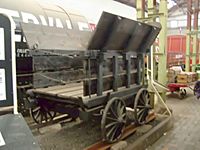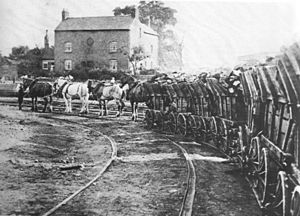Benjamin Outram facts for kids
Quick facts for kids
Benjamin Outram
|
|
|---|---|
| Born | 1 April 1764 Alfreton (Derbyshire, England)
|
| Died | 22 May 1805 (age 41) London (England)
|
| Nationality | English |
| Citizenship | British |
Benjamin Outram (born April 1, 1764 – died May 22, 1805) was an English civil engineer, surveyor, and business owner. He was a very important person in building early canals and tramways (which were like early railways).
Contents
Benjamin Outram's Life Story
Benjamin Outram was born in Alfreton, a town in Derbyshire, England. He started his career helping his father, Joseph Outram. His father worked as a land agent and helped manage land, especially during a time when many land laws were changing. He also surveyed land for new mines.
In 1803, Benjamin Outram had a son named James Outram. His son later became a famous general in the Indian Army.
Benjamin Outram died in London in 1805 from what was called a "brain fever," which was likely a stroke. After he passed away, his company, Benjamin Outram and Company, was renamed the Butterley Company in 1807.
His wife, Margaret, described him as a strong-willed person who was used to being in charge. She said he didn't have much patience for people who were slow or not very smart. After his death, his family faced some difficult times until his business matters were sorted out. Margaret Outram later died in Edinburgh and is buried there.
Outram's Engineering Career
Starting as an Engineer
Benjamin's father, Joseph Outram, helped start the Cromford Canal. When a famous engineer named William Jessop was hired to design this canal, Benjamin, who was only 24, became his helpful assistant.
While building the canal, especially the Butterley Tunnel, they found many valuable minerals. Around this time, a large estate called Butterley Hall was for sale. Benjamin's company bought the land, and this was the start of his ironworks business.
Building Canals and Railways
In 1790, Benjamin Outram started his ironworks company, 'Benjamin Outram & Company'. A year later, William Jessop and a banker named John Wright joined as partners. Benjamin was the main person running the company, helped by his younger brother, Joseph. Over time, the company grew to include quarries for limestone, kilns for making lime, and mines for coal and iron.
Outram became a big supporter of building tramways. These were special tracks that used L-shaped rails. Both the rails and the wagons that ran on them were made at his Butterley Ironworks. His very first tramway was about 1 mile (1.6 km) long. It was built to carry limestone from quarries in Crich to the Cromford Canal, which his company used.
In 1792, he became the engineer for the Nottingham Canal, and in 1793, for the Derby Canal. He also worked on the Nutbrook Canal.
One of his most important projects was the Holmes Aqueduct on the Derby Canal. It was 44 feet (13 meters) long and opened in 1796. This was one of the very first aqueducts made from cast iron. It was built by Benjamin Outram & Company.
An important addition to the Derby Canal was the Little Eaton Gangway. This was another tramway, similar to the one at Crich. These tramways became a key part of his later canal projects. Many people mistakenly think the word "tramway" came from Outram's name. However, the word actually comes from an old German word "traam," meaning "a beam." Outram himself always called these tracks "railways."
Outram was also a consulting engineer for the Huddersfield Narrow Canal. This project included the amazing Standedge Canal Tunnel, which was a pioneering achievement. In 1794, he was the engineer for the Peak Forest Canal, which included the Marple Aqueduct. The Peak Forest Tramway, about 6 miles (9.7 km) long, helped move goods up a steep climb. The Stodhart Tunnel on this tramway is thought to be the first railway tunnel in Derbyshire.
He also built railways for the Ashby-de-la-Zouch Canal, like the Ticknall Tramway. He was asked to give advice on railways for the Monmouthshire & Brecon Canal. Benjamin Outram was very forward-thinking. He believed that railways would become the most important way to transport goods and people. In 1799, he wrote that railways should all be the same width to make it easier for different types of goods to be carried.
His sudden death, without leaving a will, caused some confusion for his company. It took several years to sort out all the business matters.
See also
- Canal
- Little Eaton Gangway
- Narrowboat
- National Tramway Museum
- Peak Forest Tramway
- Ticknall
Images for kids




